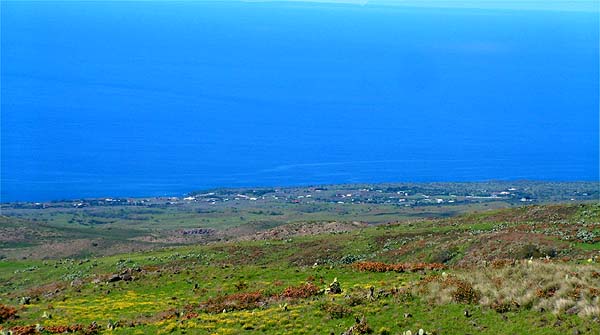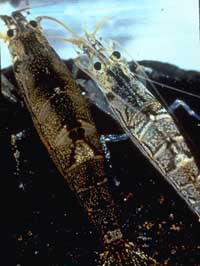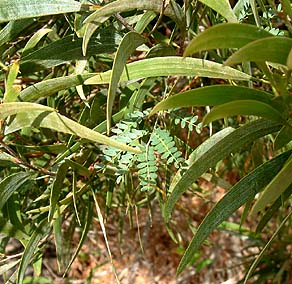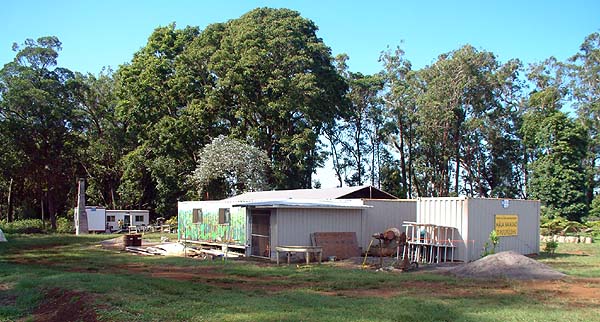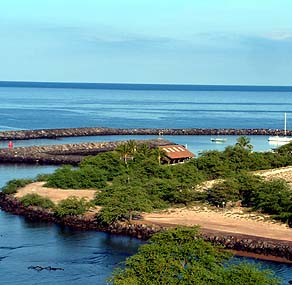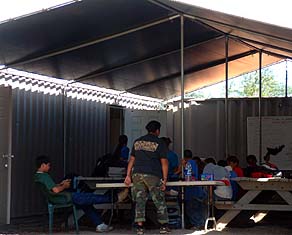 |
 |
 |
|||||
|
|
|||||||
|
|
|
|
|
“There’s nothing now that resembles the old Kawaihae, nothing,” ‘Ilima states. “All of that, how we lived, has ceased to exist for us,” Ku‘ulei agrees. “And now we don’t even have access to that. That’s how well the U.S. government and the Hawai‘i State government has kept their word, that we as Hawaiian people would have a right to these things. We have no right. They’ve actually taken away everything we’ve known for our life, so that now, even my children don’t understand what I’m telling them because they have nothing to compare it to. All of those things are gone."
|
||
|
|
||
“I have a little boat so I can take my kids out and we go and hook upupalu at night, and I take them diving and show them what I can, but most of what we needed to live on is gone. The ‘opae, that is no more. My Tutu Man, he grew taro up the road here. There’s no water anymore. The rivers don’t run unless it’s raining, unless we have floods. "It’s torn between wanting to teach your children the old ways, and figuring how we can do it now. How can I teach them, when we walk in the river to catch the ‘opae, that you don’t make the water dirty so you can find the ‘opae? "When you walk, you step lightly, instead of tromping through and getting the water all dirty, or you cannot find the ‘opae. You’re just scooping blind. But you walk gently so you don’t roll the rocks or puff up the dirt on the bottom, so you can see ‘opae. How do I teach them that when we can’t even go catch ‘opae anymore?"
|
|
|
"Or to teach them the respect for what’s there: that you don’t destroy something to take what you want and that’s it. Next time you want to come back and catch again, so we leave it the way it was so the ‘opae stay there. We know where we can get it all the time. "Now there’s no more teaching these things. We don’t think that doing these kind of things teaches us anything in life, but it does—things that stay with you. It applies to other places, to other things that we do. That maybe sometimes strength is not the idea, it’s the intelligence to know better, to go slowly, to take your time instead of the rush, rush, just get ‘em and let’s go. "It’s thinking about what you are doing. Stopping and considering what the outcome will be."
|
|
|
|
“At the Pu‘u Kohola ceremony every year, we take a huaka‘i [expedition] up into the forest," Sam says, explaining one effort at continuing education about the ahupua‘a as a cultural and environmental zone. "Recall that Pu‘u Kohola is the bottom of an ahupua‘a that runs up the mountainside to the summit of Pu‘u o Umi. And standing there at Pu‘u Kohola, you can evoke anything from the top of the mountain down, and do it rightly so. It’s not a disconnected place. That’s the kind of sense of place and its role in the whole scheme of things that allows you to do the same thing, pointing down into the ocean and invoking what’s going on there."
|
||
|
|
||
“Just because you’re working at Pu‘u Kohola or in a National Park on the coast doesn’t mean that you might not have concerns about what’s going on up in the mountains, or the flow of the water down the streams into the sea and out to the depths of the ocean. That’s the kind of thing that would have gone without question in ancient Hawai‘i, and it’s the kind of thing that most people are a little bit surprised at nowadays, because we don’t have that connection anymore. "So, part of my huaka‘i up into the Koai‘a Sanctuary is to make those kinds of points. The koai‘a is named in the Hole Waimea chant to Kamehameha, and Kamehameha’s place is down at Pu‘u Kohola at Kawaihae, so right there you have one of the discernible connections."
|
|
|
"Kanu o ka ‘Aina is a place-based model," states Ku, explaining another means by which Hawaiian environmental knowledge is being perpetuated. "One of the things that distinguishes indigenous education throughout the world is that it is always place-based. So our pedagogy is a pedagogy of place. And in that way, our place traditionally reaches from the mountain to the sea. "We have mauka [mountain] and makai [seaside] outdoor learning laboratories. We were able to develop a relatively complex mauka laboratory. On our makai campus, we’ve had some set-backs with 9/11 and Homeland Security, in that the access to our makai lab has become very, very frustrating. Our Halau Kukui, for outdoor learning, is on harbor land, and the access to the harbor has been cut off for the general public. So every time now we have to go through three different guards before we can even get to our lab, which really restricts access."
|
|
|
|
Kanu o Ka ‘Aina's mauka campus, outside of Waimea.
|
"The mauka lab provides an opportunity for students to learn hands-on how to survive in a mauka environment, so there are projects under way. One of them is an extensive horticulture complex. We’re growing a lot of things that people said can’t be grown in Waimea, and all native plants from taro to sweet potato to wauke to sugarcane to bananas and ti leaf. All the utilitarian plants primarily, with emphasis especially on food and fiber. "And then we are creating a forest-arboretum type of area where we are slowly thinning out the rubbish trees and replanting native plants in there. And the kids are making a trail through that forest, and planting native plants so that they learn about forestry as well."
|
||
|
|
||
"At the makai laboratory the emphasis is on the shoreline and the ocean. Some of the activities there have to do with fish monitoring, looking at the impact, on the fish population, of runoff, development, golf courses, and aqua-farming. So the kids do regular counts in the water and monitoring for a variety of things. "They’re also completing a greenhouse. We’re looking at re-vegetating that area with native plants. Not just in areas that we manage, but also giving it those citizens of areas that like to do more. It’s a very, very dry area, so it’s kind of like xeriscape plants that are adapted to that environment—but native plants, rather than introduced plants. "I can’t ever imagine our kupuna living makai and teaching our children how to make adzes, which is what only happened way up there in the mountains. If they’re living makai, then what they’d be teaching to the next generation would have do with living at makai."
|
|
|
"So for us now to waste time on being able to name the Presidents of the United States, for example, it’s absolutely irrelevant at every level for our students. Why waste our time with that kind of thing, when they need to know the genealogy of the chiefs from this area? "That doesn’t mean that we don’t teach them how to access information.If we’re going to look at leadership and the Presidents, then you would do that with the local ali‘i and show them how, if you want to know anybody else’s leaders, from the Americans to the Chinese to whoever, then you go into the internet and you find that out. "And so the curriculum is tailored to the place, and relevance to place, which is how our kupuna would do it."
|
|
|
|
"When it comes to the specific issues that relate to how we as twenty-first century Hawaiians can affirm our birthright, it comes down to our place. It comes down to Mauna Kea, it comes down to the fencing off areas from the pigs; it comes down to the development that all of a sudden fences in the hala trees that our kupuna used to use, so because very much what are the issues here in this community, this broader community."
|
||
|
|
||
Efforts to re-engage with the land go together with changes and efforts underway in the community itself.
|
||
|
|
||
|
|
|
|
|
|

|
| Kawaihae Home | Map Library | Site Map | Hawaiian Islands Home | Pacific Worlds Home |
|
|
|
|
|
|
|||
| Copyright 2006 Pacific Worlds & Associates • Usage Policy • Webmaster |
|||
